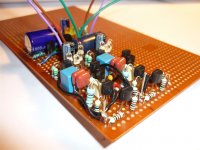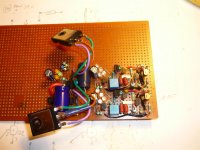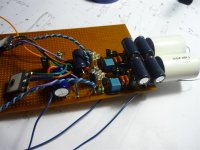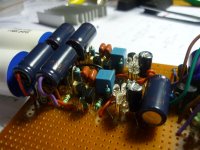Hi Salas
Was just looking back at the thread, and I didn't answer your question.
I had said I am making a valve mic & stereo valve mic preamp, but hadn't mentioned a valve phono. BUT
I have 95% made a valve phono, it is a hybrid and uses a BC549 before each half of a military CV2492 per channel (2 gain stage, 1 valve per channel).
As I say, it's 95% done. Case, turret tag boards, PSU, valve holders etc. are all done. BUT
I stepped on one of the CV2492's (with Adidas on at the time I'm glad to say !!!) and have not yet located a replacement pair of valves.
I'm not accident prone by the way, but s*#t happens !!!
I'm interested to know what tube phono's you made and what you think.
Would you reccomend one to make (I bet you made the most minimal one going !).
Have too many things on the go as it is, but a recommended super minimal tube phono would be a cool thing to get going.
I saw the photos of your regulator case on the site, is that one of the tube phonos on the coffee table next to it ?
Looks very minimal and cool in it's aly box if it is.
Cheers Simon
That was a modified Steve Bench cascode. I had also listened with Allen Wright's, Thorsten's, etc. Last I made and my mates liked it best is that: http://www.diyaudio.com/forums/analogue-source/140635-valve-itch-phono.html I recommend it be powered by a Simpler Simplistic HV reg.
Interesting what you say about taping the valves.
I recently made a passive hi/lo EQ for an analogue reverb.
Something was VERY wrong.
Checked the obvious things, no luck.
Fiddling around with the circuit I eventualy discovered a problem with one of the capacitors.
This mu fu' was TOTALY MICROPHONIC, BIG TIME !
It was a 2.2uF polycarbonate from my cap box.
Since then have got a case of capacitor neurosis.
I now tap every thing from 47,000uF to 0.001uF ceramic just to sleep at night.
I was shocked to discover this pronounced microphony in a cap.
Cap measured fine on the meter.
Simon.
I recently made a passive hi/lo EQ for an analogue reverb.
Something was VERY wrong.
Checked the obvious things, no luck.
Fiddling around with the circuit I eventualy discovered a problem with one of the capacitors.
This mu fu' was TOTALY MICROPHONIC, BIG TIME !
It was a 2.2uF polycarbonate from my cap box.
Since then have got a case of capacitor neurosis.
I now tap every thing from 47,000uF to 0.001uF ceramic just to sleep at night.
I was shocked to discover this pronounced microphony in a cap.
Cap measured fine on the meter.
Simon.
My Salas Phono-Pre
Hi People,
I have been lurking around the DIY sites for quite a while now and the time has come to post something... hopefully one day I'll have something to contribute... until then, please go easy.
A very brief summary of my goals: I am out to build a truly great sounding DJ console and small club system, starting with the mixer. Given I want a mixer better than anything commercially available, past or present, I figured I need to start with a fantastic phono preamp. So I start I did...
I have built an ESP P06, a mini-tube kit K282 from Oatley Electronics and I have just completed the Salas Simplistic: MM version with Shunt Reg, all as per psgr's PDF document from months ago.
My setup currently:
- Denon DP-DJ101 turntable
- Ortofon Concorde Pro carts
- BlueSky ProDesk MKII active studio monitor system (currently at MKIII so online doc is not so relevant, but system is in the upper end of pro-sumer studio grade and can be seen here)
- Apogee Ensemble audio interface
- Vestax PCV-275 DJ mixer (Don't even bother with specs and sound , despite it being considered one of the better units, though certainly not best)
, despite it being considered one of the better units, though certainly not best)
I'll be moving towards getting Technics 1200 series turntables with tone arm and power supply upgrades (as the 12xx's are so standard in DJing and I have heard great things about this TT with upgrades). Carts are likely to be Concordes or Shure M44-7. This is another area I am looking to expand capabilities, though options are low in good DJing carts and I'm sure that none come close to audiophile offerings. Any cart suggestions are enthusiastically welcomed, however back cueing (yes we spin 'em backwards) and high tracking ability are a must. I doubt that these are design features of a sub-millivolt MC, unfortunately.
On to the Salas. I'll reduce the ramble and state the obvious... it's the best so far in my very simple (yet revealing) listening tests. Mine has been constructed with rather basic parts on cheap perf-board using an under-sized EI traffo and crappy hook-up wire... I have attached photo's of my modest effort.
While I am not to keen to spend countless hours tweaking (mainly because the whole project is so immense that I can't afford too much time on each component) I am keen to practically get an unprecedented sound from a DJ setup, so I must hone each stage somewhat.
With all of the above insight to my goals, could you please apply your massive collective knowledge to help me through some key improvements over my build to get more out of this great phono-pre. I have found some posts regarding recent circuit developments and hundreds regarding component rolling... I guess I'm looking for an overview of developments that are well worth trying out in my unique situation.
If a specific BOM used helps, I'll put it up. The post is already so long I won't add to it right now.
Many thanks to everyone here and I look forward to getting more from my records.
Regards,
Tani.
Hi People,
I have been lurking around the DIY sites for quite a while now and the time has come to post something... hopefully one day I'll have something to contribute... until then, please go easy.
A very brief summary of my goals: I am out to build a truly great sounding DJ console and small club system, starting with the mixer. Given I want a mixer better than anything commercially available, past or present, I figured I need to start with a fantastic phono preamp. So I start I did...
I have built an ESP P06, a mini-tube kit K282 from Oatley Electronics and I have just completed the Salas Simplistic: MM version with Shunt Reg, all as per psgr's PDF document from months ago.
My setup currently:
- Denon DP-DJ101 turntable
- Ortofon Concorde Pro carts
- BlueSky ProDesk MKII active studio monitor system (currently at MKIII so online doc is not so relevant, but system is in the upper end of pro-sumer studio grade and can be seen here)
- Apogee Ensemble audio interface
- Vestax PCV-275 DJ mixer (Don't even bother with specs and sound
 , despite it being considered one of the better units, though certainly not best)
, despite it being considered one of the better units, though certainly not best)I'll be moving towards getting Technics 1200 series turntables with tone arm and power supply upgrades (as the 12xx's are so standard in DJing and I have heard great things about this TT with upgrades). Carts are likely to be Concordes or Shure M44-7. This is another area I am looking to expand capabilities, though options are low in good DJing carts and I'm sure that none come close to audiophile offerings. Any cart suggestions are enthusiastically welcomed, however back cueing (yes we spin 'em backwards) and high tracking ability are a must. I doubt that these are design features of a sub-millivolt MC, unfortunately.
On to the Salas. I'll reduce the ramble and state the obvious... it's the best so far in my very simple (yet revealing) listening tests. Mine has been constructed with rather basic parts on cheap perf-board using an under-sized EI traffo and crappy hook-up wire... I have attached photo's of my modest effort.
While I am not to keen to spend countless hours tweaking (mainly because the whole project is so immense that I can't afford too much time on each component) I am keen to practically get an unprecedented sound from a DJ setup, so I must hone each stage somewhat.
With all of the above insight to my goals, could you please apply your massive collective knowledge to help me through some key improvements over my build to get more out of this great phono-pre. I have found some posts regarding recent circuit developments and hundreds regarding component rolling... I guess I'm looking for an overview of developments that are well worth trying out in my unique situation.
If a specific BOM used helps, I'll put it up. The post is already so long I won't add to it right now.
Many thanks to everyone here and I look forward to getting more from my records.
Regards,
Tani.
Attachments
One simple improvement would be to change the reg's Zener to a resistor (I will give you the value if you tell me your Vout and mV across the 10R under the 2SK170 at Zener's base), another is to tweak your C3 capacitor's value on the phono to your best HF alignment liking. But if you find the tonality OK in your system and you have no buzz or hum you are basically done. Don't you sink the Mosfets BTW? Using R1 10R in the regs? Also cabling to them Mos is not good, at least apply the 220R gate stoppers directly on their G pins.
I'm posting from work  so can't measure now, but I'll come back with these. Yes, the MOSFETs are sinked, just not in these pics as it was still under construction. As for 10R, I'm trying to remember the schem in the pdf, but I know that the lowest Vout reg used a 6R8 compared to 10R for the higher output reg's... I used 6R8 here.
so can't measure now, but I'll come back with these. Yes, the MOSFETs are sinked, just not in these pics as it was still under construction. As for 10R, I'm trying to remember the schem in the pdf, but I know that the lowest Vout reg used a 6R8 compared to 10R for the higher output reg's... I used 6R8 here.
Thanks again for your hard work... the bug has bitten and I'm having fun!
Thanks again for your hard work... the bug has bitten and I'm having fun!
Shunt's R4 in the Psgr's pdf is the one I want the mV measured across. Measure your reg's output voltage too. R1 is the one that sets the current. Yes, it was 6R8 in the MM since it could run more current which is beneficial and save on dissipation due to lower Vout than for the MC circuit. Is it no buzz, no hum in your system, and is the tonality OK from bass to treble in your system? You did not tell me. Because there are Pro carts involved which have quirks with the capacitive load and HF, I wanna know it ties OK as a whole. Because by tweaking C3 it can be ironed out in case of wanting something.
Ok I'll check these values, thanks.
The capacitive cart load is yet to be installed and I understand that this will affect the sound significantly. Your particular attention to this point further highlights it's importance to me. I will install this and adjust before commenting further on the sound in this regard (though as I said, I'm happy so far... the highs are already much more involving and full of life than with the others I have compared your pre to). On the matter of capacitance, I deviated from the schem by placing 10.0uF output caps in... simply because I had them. Increasing output caps with a given output resistance will simply reduce the low-cut corner freq, won't it?
The system doesn't buzz but I have hum. However I didn't comment on this as there is much shielding to be done and it will only worry me if the hum is still present after wiring and shielding properly.
The capacitive cart load is yet to be installed and I understand that this will affect the sound significantly. Your particular attention to this point further highlights it's importance to me. I will install this and adjust before commenting further on the sound in this regard (though as I said, I'm happy so far... the highs are already much more involving and full of life than with the others I have compared your pre to). On the matter of capacitance, I deviated from the schem by placing 10.0uF output caps in... simply because I had them. Increasing output caps with a given output resistance will simply reduce the low-cut corner freq, won't it?
The system doesn't buzz but I have hum. However I didn't comment on this as there is much shielding to be done and it will only worry me if the hum is still present after wiring and shielding properly.
Reduce the output capacitor's value if you ever buy an Obbligato down to 2.2-3.3uF if your next stage isn't lower input than 20K Ohm. Not having to pay for 10uF that will allow more infrasonic rumble on top of the expense. Maybe your carts are already loaded well with what the TT cables and residual input capacitance provide. In any case for an MM two things can help you nail the final system best HF balance. One is to substitute the Rload input resistor to ground with a 100k trimmer wired with its middle pin and low pin together to ground. By tweaking that, the cart's HF change. Another way is tweak C3, is the HF riaa cap. If you will feel too much treble, add value, if you feel soft treble reduce value. 15.3-16.1nF play should give enough trends. Maybe there is more in the TT and carts to tune and listen to even better although it may be ''wow'' already. Hum is normal in a non boxed phono. Buzz could be a loop. Use shielded coax for signal and keep the trafo outside. You got a tight perfboard layout and that is good.
Thanks for the input Salas, very much appreciated. I had the 10.0uF caps from another project and had ordered some 3.3uF Soniq's from ebay, but only 1 arrived!!! (I'm still chasing that... grrr). I'll try the input trimmer as that's the easiest to change first, and I'm sure the hum will disappear with an enclosure.
I'm also glad that you consider the tight layout a positive... it was more like building mini-models than soldering.
I'm also glad that you consider the tight layout a positive... it was more like building mini-models than soldering.
Great read. Certainly makes me wonder if I should build some a variable input loading device to wire any pre-amp under test through, minus the Rload & Cload of the amp itself of course. It looks like the loading alone could be enough to wrongly turn me off a given circuit if it weren't optimum. Thanks for the further insight. The learning continues.
The preamps don't vary significantly for residual input capacitance in most cases. And they all got 47K for MM. If there is no purpose added pF parallel to their input of course. The carts differ a lot in needs. Best tactic IMO for those who want to be checking best MM loading is to use no extra cap no matter what the manufaturer says, use a 100k trimmer, hunt high to low, and when settled after enough records, subtitute the arrived at value with a good resistor.
Of course... it's cartridge loading, not pre-amp loading... silly me. I'll apply this method and see what I come up with. Given it is unlikely that I'll be changing carts too often, I could fix this value once decided. Are there any pots or trimmers that are good enough to remain in this location for future adjustments for cart changes?
The preamps don't vary significantly for residual input capacitance in most cases. And they all got 47K for MM. If there is no purpose added pF parallel to their input of course. The carts differ a lot in needs. Best tactic IMO for those who want to be checking best MM loading is to use no extra cap no matter what the manufaturer says, use a 100k trimmer, hunt high to low, and when settled after enough records, subtitute the arrived at value with a good resistor.
My friend Chris is using the Hagerman Piccolo MC (without RIAA) togheter the Puresound P10 MM (with RIAA), now is time to upgrade the MM & the question is: it's necessary also the 100K trimmer when is connected before the MC phono preamp?
Balanced Simplistic NJFET RIAA
One photo my Balanced Simplistic NJFET Phono RIAA just for fun:
To finish only needs the 15nF RIAA caps.
One photo my Balanced Simplistic NJFET Phono RIAA just for fun:
An externally hosted image should be here but it was not working when we last tested it.
To finish only needs the 15nF RIAA caps.
My friend Chris is using the Hagerman Piccolo MC (without RIAA) togheter the Puresound P10 MM (with RIAA), now is time to upgrade the MM & the question is: it's necessary also the 100K trimmer when is connected before the MC phono preamp?
No way for MC carts. This is for MM carts only that have high inductance and react with hundreds of pF and tens of Kohm. The pre pre loads the MC and expects 47K MM input.
- Home
- Source & Line
- Analogue Source
- Simplistic NJFET RIAA



